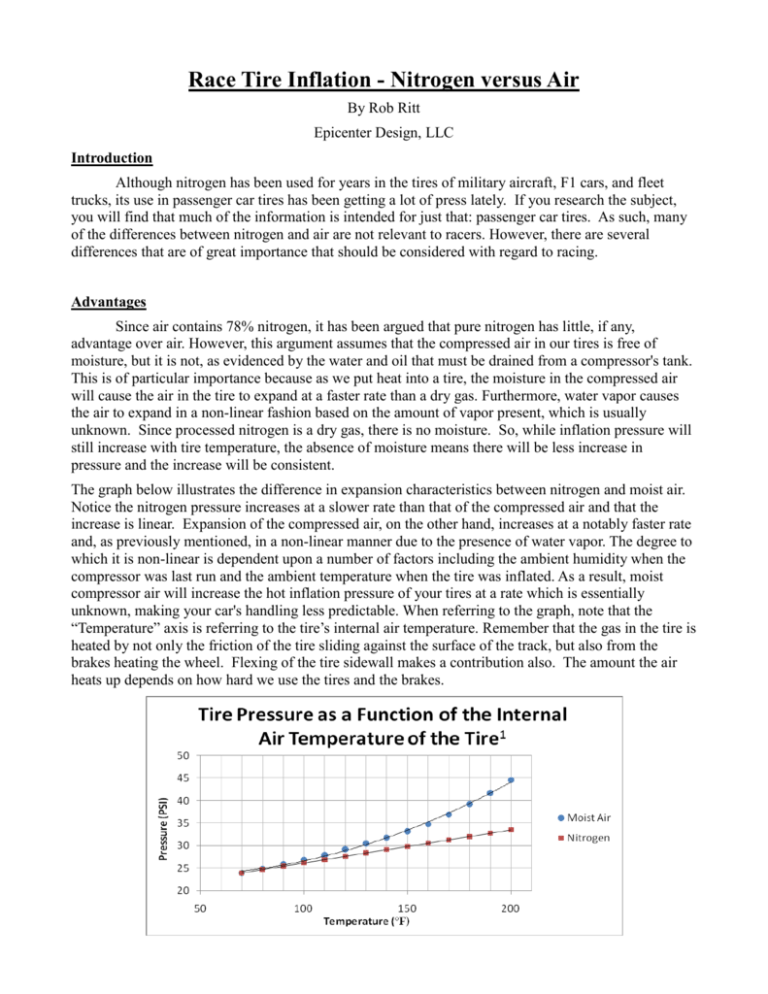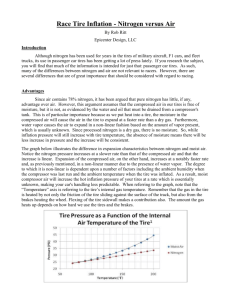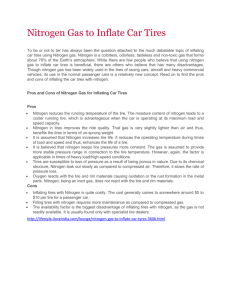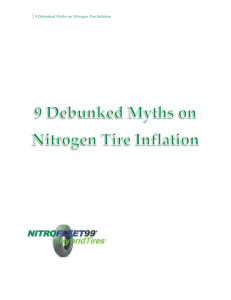Race Tire Inflation - Nitrogen versus Air
advertisement

Race Tire Inflation - Nitrogen versus Air By Rob Ritt Epicenter Design, LLC Introduction Although nitrogen has been used for years in the tires of military aircraft, F1 cars, and fleet trucks, its use in passenger car tires has been getting a lot of press lately. If you research the subject, you will find that much of the information is intended for just that: passenger car tires. As such, many of the differences between nitrogen and air are not relevant to racers. However, there are several differences that are of great importance that should be considered with regard to racing. Advantages Since air contains 78% nitrogen, it has been argued that pure nitrogen has little, if any, advantage over air. However, this argument assumes that the compressed air in our tires is free of moisture, but it is not, as evidenced by the water and oil that must be drained from a compressor's tank. This is of particular importance because as we put heat into a tire, the moisture in the compressed air will cause the air in the tire to expand at a faster rate than a dry gas. Furthermore, water vapor causes the air to expand in a non-linear fashion based on the amount of vapor present, which is usually unknown. Since processed nitrogen is a dry gas, there is no moisture. So, while inflation pressure will still increase with tire temperature, the absence of moisture means there will be less increase in pressure and the increase will be consistent. The graph below illustrates the difference in expansion characteristics between nitrogen and moist air. Notice the nitrogen pressure increases at a slower rate than that of the compressed air and that the increase is linear. Expansion of the compressed air, on the other hand, increases at a notably faster rate and, as previously mentioned, in a non-linear manner due to the presence of water vapor. The degree to which it is non-linear is dependent upon a number of factors including the ambient humidity when the compressor was last run and the ambient temperature when the tire was inflated. As a result, moist compressor air will increase the hot inflation pressure of your tires at a rate which is essentially unknown, making your car's handling less predictable. When referring to the graph, note that the “Temperature” axis is referring to the tire’s internal air temperature. Remember that the gas in the tire is heated by not only the friction of the tire sliding against the surface of the track, but also from the brakes heating the wheel. Flexing of the tire sidewall makes a contribution also. The amount the air heats up depends on how hard we use the tires and the brakes. In order to gain a sense of how much temperature increase we might expect, we can use the Ideal Gas Law which states that PV = nRT. In this equation, P = pressure, V = volume, n = the amount of the gas, R = the gas constant (for the appropriate gas), and T = temperature. With a little manipulation, we can state this equation as P/T=nR/V. If we assume that n,R, and V are constant, then we can set the equations for both cold inflation and hot inflation equal to each other to get P1/T1=P2/T2. The temperature must be in degrees Kelvin. If we assume a cold inflation pressure of 20 PSI, an air temperature of 70 °F (294.3 K), and a hot inflation pressure of 24 PSI, solving for T2 we find that the temperature of the air has increased to 176 °F (353.1 K)! Another frequently mentioned advantage is the fact that nitrogen permeates through the sidewall of a tire more slowly than air. Although the difference is small and requires a substantial length of time to create a significant difference, it is to our benefit that it leaks out more slowly. However, since tire pressures are set frequently, this phenomenon alone does not warrant the use of nitrogen. Some proponents of nitrogen in passenger car tires point out that oxygen in the air will, given sufficient time, oxidize the rubber causing it to break down. However, tire manufacturers formulate the rubber compound to slow this attack. Hopefully, a set of tires will be worn out from racing long before they suffer significant deterioration from atmospheric exposure. However, because nitrogen is a dry inert gas, it slows internal degradation of both the rubber tire and the metal wheel. This is of particular significance for cars where the tires are infrequently replaced. Since few people have unlimited racing budgets, cost is another facet of this decision. A common size of nitrogen cylinder (Ø9.25 inches x 60 inches) rents for approximately $70 for six months. That's relatively inexpensive compared to the cost of a compressor which may cost several hundreds of dollars and requires either gasoline or electricity to operate. Another plus to using nitrogen is that it eliminates the need for air compressor maintenance and you probably already have enough pieces of equipment to maintain. Disadvantages By this point, you might be asking if there are any disadvantages and, as with most things, there are. Chief among these is limited supply. Your nitrogen supply is limited to what you bring to the track. However, this is not as much of a concern as you might think. A cylinder measuring Ø9.25 inches x 60 inches will run a pneumatic tool (e.g., a die-grinder) for approximately 20 minutes with no loss of performance. When you consider that most of your compressed gas use involves small tire pressure adjustments and only brief periods of consumption during pneumatic tool operation, that's a very long time. Safety Safety is also a consideration, as with the storage and handling of any gas cylinder, whether it is argon, acetylene or even propane for your grill. Nitrogen is a colorless, odorless, tasteless, and mostly inert diatomic gas and as a result, humans possess no sense that will detect it. Because of this, suffocation can be a hazard of unsafe use, particularly in enclosed spaces. If the contents of a cylinder were to escape into an enclosed trailer, garage, or another space with limited ventilation, oxygen levels could be reduced to an unsafe level. Suffocation can occur quickly and may not have any warning signs. You might not even feel "light-headed" before losing consciousness; you may simply pass out without any warning whatsoever. Always be sure to have adequate ventilation. High pressure cylinders also have enough stored energy to become airborne if the valve is broken off. Therefore, cylinders should always be handled with care and secured to something sturdy. The cap should always be in place when the cylinder is not in use. Where the law is concerned, a few preventative steps are less expensive than a citation. Some states require that your trailer have the appropriate compressed gas decals. Carrying the Material Safety Data Sheet (M.S.D.S.) for nitrogen is a good idea also. Check with your local law enforcement to verify what is required in your area. Conclusion The advantages of using nitrogen far exceed the few drawbacks and are substantially better than using compressed air. Nitrogen provides more predictable handling, doesn't contain potentially corrosive water vapor, needs to be replaced less frequently, and is fairly inexpensive. Data adapted from the presentation “Nitrogen Inflation for Truck Tires” by Guy Walenga of the Bridgestone/Firestone Corporation. Presented during the Clemson Tire Conference, March 11, 2004. Document accessed September 17, 2010. <http://www.tiresavernitrogen.com/pdf/Technical%20%20Bridgestone%20Research%20-%20Walenga.pdf> 1








